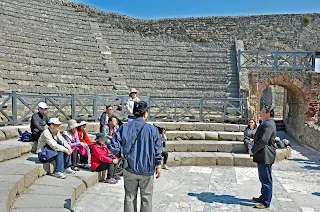The city of Pompeii started out as a port for Phoenicians and Greeks to ride out storms about 800BC. Because of its climate, natural harbor and fertile farmlands, it became a popular place to live in, but by the time of the Summer of '79 (AD), after being a Roman city for only 169 years, and a popular summer resort, it came to an end. Our contemporary city of Pompei, built right up to the edges of the ancient ruins, was located there for the same reasons that the original settlers had for being there.
The elaborate Ionic Capitol above is set on a half column, mostly as a pedistal in a spot right next to the forum. The column is made of brick with a hard plaster coat around it in the fluted Greek mode. All the structures were covered by a several meter thick volcanic ash ruble from the plume which rose over 10 miles above Vesuvius and rushed toward Pompeii with a powerful wind. The immense heat and thick ash doomed the city.
Below, the construction can be seen, the main and original forum is beyond.
Here is the main Forum, the heart of the city, with Vesuvius 5km away, an everpresent sight.
The Fourm had large public buildings surrounding it, temples and government offices, united by the ring of columns seen above.
Walking along the edge of the Forum along the Cardo, the main N-S street, Vesuvius gets larger for us, but the ancient Pompeiians weren't able to see it from here, as the buildings were so large.
Up ahead is the last remaining business,
Pizza and fast food for the turisti. Actually...
...this was the 'Pizza' spot.
There are several of these businesses around the town, where grain was milled above in those funnel topped
mills. The grain was poured in the top, the workers turned the mill with wooden arms
set in the square holes, and the farina came out the bottom. Fresh and put to use with water and whatever, and popped right into the waiting ovens, daily, and sold to those for snack or to take home. Not too much taking home as most ate out with others, a kind of constant party between work. Slowfood made quickly...
This is a part of the baths, showing skylights and milling about area, I guess.
The ceilings are beautifully incised with plaster decorations. Note the broken panel...
...here can be seen the hollow channels within the walls. The ancients had wood fires below and the tile floor was heated, as were the walls with the heat rising through the ducts. No need for that extra muffler here.
This is the ante room, where one stowed his/her toga and stuff, in the cubbies between the carved dieties.
Home, for those who had one, usually had a central cortile, for water,
though they did have a sophisticated aquaduct system for the city, kitchen herbs and verdure.
The access to the sun allowed light into the house as the walls abutted others and there were no windows.
Rooms opened up to the cortile, like this richly colored room.
Or, this room from the Villa of Misteri, with wall panels showing initiation rites for brides to be.
And au currant tile floors...
with wonderful, painstaking detail throughout.
Here. a visitor is walking across the inner circle where the audience sat in
their chairs, others sat in their chair in the wide arc, and the rest
sat on the stone theater steps above. This large theater is used today as part of PompeiiViva, a
summer series designed to activate the city. The original egressi are used to good effect. The stage,
seen in front of the wall to the left, is under reconstruction at the moment.
Originally, there were canvas awnings over parts of the audience to provide shade, the vertical posts can be seen behind the girls above, and below:
In this view, the theater can be seen on the other side of the courtyard wall,
showing the tall posts and seating.
Another theater, quite smaller, known as the Odeion, was enclosed by a roof. This little theater was acoustically excellent. It was for reciting odes. Above is a Japanese tour group, and a visitor watches...
as one, a tenor, tries out the accoustics with
his rendering of o sole mio...Bellissimo!
We walked toward the necropolis, the modern city of Pompei is jammed right up to the edges of the
old city. We are lucky that it was found and protected in time...
We continue to walk the old streets toward our egress and
a wonderful pranza at the Casa Lucius in the outer world.
with thanks to ST, for the photos of the visitor.






















No comments:
Post a Comment